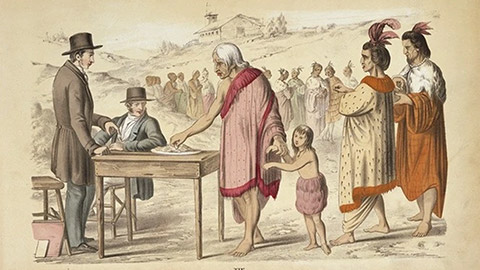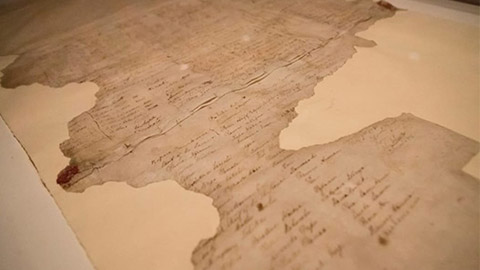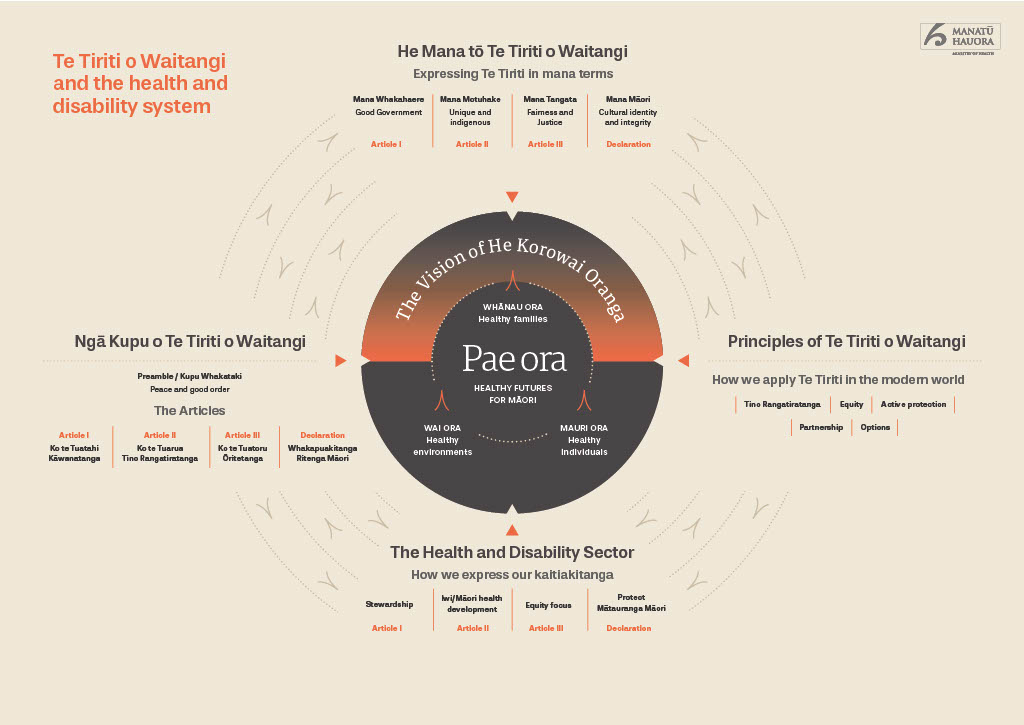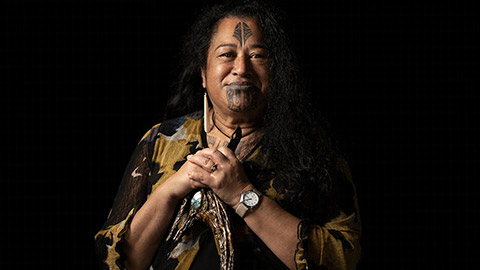
The Treaty of Waitangi, or Te Tiriti o Waitangi, is New Zealand's founding document. The Treaty was signed in 1840 and promised to protect Māori culture and to enable Māori to continue to live in New Zealand as Māori. It also gave the Crown the right to govern New Zealand and represent all New Zealanders' interests.
The Treaty acknowledges and respects Māori as the indigenous people of the land by protecting the rights of Māori to keep their land, forests, fisheries and treasures while handing over sovereignty to the English.
The document:
- recognises that Māori occupied New Zealand before the British settlement
- promises to protect Māori culture and to enable Māori to continue living in New Zealand as Māori
- gives the Crown the right to govern and establish laws in the interests of all New Zealanders and to develop British settlement
- gives Māori the same rights and status as British citizens.

The Treaty of Waitangi is a short document made up of three main parts.
- Preamble: The opening section of the document expressing the intentions of the signing parties.
- Articles: The main body is divided into three articles outlining specific agreements between Māori and the Crown.
- Signatures: Approximately 40 chiefs signed the Māori version on 6 February 1840, acknowledging their full commitment to Te Tiriti. Throughout 1840, an additional 500 Māori from various regions signed the document. Lieutenant-Governor William Hobson and other representatives of the British Crown signed the English version of the Treaty.
The three articles of the treaty have been interpreted and developed into a set of principles.
The principles as they relate to healthcare
It's important to note that these principles are not exhaustive and may be interpreted and applied in various ways within different health contexts. They provide a framework for addressing Māori health disparities and promoting equitable health outcomes in New Zealand. We have also provided an example of each principle you could apply as a community health worker.
Tino Rangatiratanga | Self-Determination
This principle ensures Māori self-governance and independent authority. This could extend to the planning, implementation, and oversight of health and disability services.
Example: Allowing service users the time and opportunity to choose what they believe is best for their health and wellbeing.
Pātuitanga | Partnership
This principle emphasises the need for collaboration and shared decision-making between Māori and the government or health authorities. It recognises the importance of Māori involvement in policy development, planning, and service delivery to ensure equitable health outcomes.
Example: Collaborate with service users to deliver tailored support that meets their needs and preferences.
Mana Taurite | Equity
This principle recognises the importance of achieving fair and just health outcomes for all individuals and communities, particularly addressing the existing disparities Māori face. It involves addressing social determinants of health, reducing inequalities, and ensuring that health services are accessible, appropriate, and effective for Māori.
Example: Promote equitable outcomes by ensuring the availability of a diverse range of resources.
Whakamarumarutia | Active Protection
This principle recognises and respects Māori cultural practices and beliefs within healthcare settings. This could include providing culturally appropriate healthcare services and the involvement of Māori communities in the decision-making processes.
Example: Strive to deliver comprehensive health services and achieve desired outcomes that address the individual needs of service users.
Kōwhiringa | Options
This principle recognises that Māori should have the opportunity to weigh in on the options within the healthcare system to meet their specific needs and aspirations.
Example: Empower service users with the opportunity to actively participate in ensuring their treatment aligns with their cultural values and preferences.
Learning Checkpoint
Manatu Hauora/Ministry of Health has developed a framework to ensure the principles of Te Tiriti o Waitangi are being met.
Download the document here.

According to the summary document by Network Waitangi Otautahi, the Treaty in the Māori language was signed by Captain Hobson and over 500 rangatira, over 40 of them at Waitangi on February 6th 1840.
The English version, only written after February 6th, was signed at Port Waikato/Manukau, where the discussion would have been of the content of the Māori text, but the English version was signed (by approximately 40 rangatira).
When the two documents conflict
In international law where there is any ambiguity:
- the contra proferentem principle applies, which means that a decision is made against the party that drafts the document
- the indigenous language text takes preference.
In oral cultures such as Maori, verbal agreements take preference over what is written.
This means that the text in te reo takes precedence on all these counts for the Treaty of Waitangi.
Examining Contentions within the Treaty
The Māori keywords in the Treaty of Waitangi that have caused disagreements and different interpretations are primarily related to sovereignty, ownership, and governance. Here are some of the main points of contention:
-
Rangatiratanga | Chieftainship: Māori argue that by agreeing to "kia tohungia ki a ratou o ratou rangatiratanga" (retaining their chieftainship), they intended to maintain their authority and control over their lands and resources. However, the British Crown interpreted this as a transfer of sovereignty to the Crown.
-
Wenua | Lands: The Māori version uses the term "o ratou wenua" (their lands), implying Māori ownership and control. The English version, on the other hand, uses "their lands and estates," suggesting a broader interpretation that includes the Crown's interests.
-
Kawanatanga | Governance: The Māori version refers to the Crown's "Kawanatanga o te Kuini" (governance of the Queen), while the English version mentions "the Queen's Government." The difference in terminology has led to debates over the extent of Māori self-governance and the authority of the Crown.
-
Tino rangatiratanga | Full Chieftainship: The Māori version states that Māori have "te tino rangatiratanga o o ratou wenua" (the full chieftainship of their lands). Some argue that this implies exclusive Māori control, while others contend it can be reconciled with Crown sovereignty.
These keyword differences, coupled with cultural and historical factors, have contributed to ongoing debates and legal disputes regarding the interpretation and implementation of the Treaty of Waitangi.
Waitangi Tribunal Decisions
In November 2014, the Waitangi Tribunal summarized their conclusions on the Nga Puhi claim (Wai 1040):
- The rangatira who signed te Tiriti o Waitangi in February 1840 did not cede their sovereignty to Britain. They did not give up the authority to create and enforce laws over their people or territories.
- The rangatira agreed to share power and authority with Britain. They agreed that the Governor would have the authority to control British subjects in New Zealand in order to maintain peace and protect Māori interests.
- The rangatira consented to the treaty based on the understanding that they and the Governor would be equals, although they would have different roles and areas of influence. The specifics of how this relationship would function in practice, particularly in areas where Māori and European populations interacted, were intended to be negotiated over time on a case-by-case basis.
- The rangatira agreed to engage in land transactions with the Crown, and the Crown promised to investigate pre-treaty land transactions and return any land that had been improperly acquired from Māori .
- The rangatira also seemed to have agreed that the Crown would provide protection against foreign threats and represent them in international affairs as necessary.
Full Text of the Treaty
Click the + expand button on the right to reveal the full text of both treaty versions. You can also view a contemporary translation on the original te reo Māori text on Te Papa's website.
He Kupu Whakataki,
Ko Wikitoria, te Kuini o Ingarani, i tana mahara atawai ki nga Rangatira me nga Hapu o Nu Tirani, i tana hiahia hoki kia tohungia ki a ratou o ratou rangatiratanga, me to ratou wenua, a kia mau tonu hoki te Rongo ki a ratou me te ata noho hoki, kua waka(a)ro ia he mea tika kia tukua mai tetahi Rangatira hei kaiwakarite ki nga tangata Maori o Nu Tirani. Kia wakaaetia e nga Rangatira Maori te Kawanatanga o te Kuini ki nga wahi katoa o te wenua nei me nga motu. Na te mea hoki he tokomaha ke nga tangata o tona iwi kua noho ki tenei wenua, a e haere mai nei.
Na ko te Kuini e hiahia ana kia wakaritea te Kawanatanga, kia kaua ai nga kino e puta mai ki te tangata Maori ki te Pakeha e noho ture kore ana.
Na kua pai te Kuini kia tukua ahau, a Wiremu Hopihana, he Kapitana i te Roiara Nawi, hei Kawana mo nga wahi katoa o Nu Tirani i tukua aianei a mua atu ki te Kuini; e mea atu ana ia ki nga Rangatira o te Wakaminenga o nga Hapu o Nu Tirani, me era Rangatira atu enei ture ka korerotia nei.
Ko te tuatahi,
Ko nga Rangatira o te Wakaminenga, me nga Rangatira katoa hoki, kihai i uru ki taua Wakaminenga, ka tuku rawa atu ki te Kuini o Ingarani ake tonu atu te Kawanatanga katoa o o ratou wenua.
Ko te tuarua,
Ko te Kuini o Ingarani ka wakarite ka wakaae ki nga Rangatira, ki nga Hapu, ki nga tangata katoa o Nu Tirani, te tino Rangatiratanga o o ratou wenua o ratou kainga me o ratou taonga katoa. Otiia ko nga Rangatira o te Wakaminenga, me nga Rangatira katoa atu ka tuku ki te Kuini te hokonga o era wahi wenua e pai ai te tangata nona te wenua ki te ritenga o te utu e wakaritea ai e ratou, ko te kaihoko e meatia nei e te Kuini hei kaihoko mona.
Ko te tuatoru,
Hei wakaritenga mai hoki tenei mo te wakaaetanga ki te Kawanatanga o te Kuini. Ka tiakina e te Kuini o Ingarani nga tangata Maori katoa o Nu Tirani. Ka tukua ki a ratou nga tikanga katoa rite tahi ki ana mea, ki nga tangata a Ingarani.
Ko te tuaw,
E mea ana te Kawana ko nga wakapono katoa o Ingarani, o nga Weteriana, o Roma, me te ritenga Maori hoki e tiakina ngatahitia e ia.
Na, ko matou, ko nga Rangatira o te Wakaminenga o nga Hapu o Nu Tirani, ka huihui nei ki Waitangi. Ko matou hoki ko nga Rangatira o Nu Tirani, ka kite nei i te ritenga o enei kupu ka tangohia, ka wakaaetia katoatia e matou. Koia ka tohungia ai o matou ingoa o matou tohu.
Ka meatia tenei ki Waitangi, i te ono o nga ra o Pepueri, i te tau kotahi mano, e waru, e wa tekau o to tatou Ariki.
(Signed at Waitangi on the 6th February 1840 and afterwards around the country by over 500 rangatira)
Victoria, the Queen of England, in her gracious thoughtfulness to the Rangatira and Hapu of New Zealand, and in her desire to record both her recognition of their paramount authority and that the lands are theirs so that al may live in peace and good order, has thought it night to send an officer to make arrangements with the people of New Zealand. Let the Rangatira agree to the Kawanatanga (governorship - the delegated duty to govern Pakeha and other non-Maori) of the Queen over all parts of this land and its islands. This is to be done because a great number of her people have settled in this country, and others will come.
The Queen desires to arrange Kawanatanga so that no evil come to the Maori people or to the Pakeha who are living here in a state of lawlessness.
Now the Queen has been pleased to send me, William Hobson, a Captain in the Royal Navy, to be the Kawana for all parts of New Zealand which have been allocated or shall be allocated to the Queen. And she says to me Rangatira of the Confederation of the Hapu of New Zealand and the oner Rangatira, these are the laws spoken of.
This is the first
The Rangatira of the Confederation and all the other Rangatira who have not joined that Confederation delegate Kawanatanga to the Queen of England forever for lands entrusted to Pakeha and other non-Maori.
This is the second
The Queen of England will make the arrangements and recognises the Tino Rangatiratanga (retained paramount and ultimate authority, which includes sovereignty) of the Rangatira, Hapu and all the people of New Zealand over their lands, villages and everything else that is held precious. But the Rangatira of the Confederation and all the other Rangatira allow the Queen to trade for the use of those pieces of land that the owners consent to allocate, subject to agreement over payment which will be agreed to between the Rangatira and an agent who will be appointed by the Queen.
This is the third
This is the arrangement for the agreement to the Queen’s Kawanatanga. The Queen will care for all the Maori people of New Zealand and ensure that they have the same access to the laws and customs as the people of England.
This is the fourth
The Governor says that all faiths - those of England, of the Wesleyans, of Rome and also Maori custom and religion - shall all alike be protected by him.
(This fourth article was agreed to before any of the Rangatira had signed the Treaty. It came about when the Catholic Bishop Pompallier asked Hobson that there be a guarantee of freedom of religion. The Anglican missionary William Colenso subsequently worded the article then Hobson and the Rangatira agreed to it.)
Now we, the Rangatira of the Confederation of the Hapu of New Zealand, assembled here at Waitangi and we, the other Rangatira of New Zealand, understand the intent of these words and agree to their entirety, and so we put here our names and our marks.
Done at Waitangi on the 6th day of February in the year of our Lord 1840.
Activity - Document Analysis
In this activity, you will be watching a documentary show as part of the I am series produced by TVNZ 1.
The local doco series tells the true stories of real people living in unique or diverse circumstances. The selected show is a 45-minute intimate account of Tui Taurua's journey into empowerment. Tui spent more than two decades in and out of psychiatric hospitals because of the way the western lens viewed the voices she was hearing in her head.
The following questions are a starting point for discussions when you meet up during the Live Session with your tutor and peers:
- What emotions have surfaced when you watch this doco?
- How does the Western worldview differ to Māori worldview when it comes to 'hearing voices'?
- What Māori health model was mentioned that has helped Tui look at her situation differently?
You will need to sign up to TVNZ On Demand to watch the series.
Let's watch.
I Am–I Am Tui Taurua: I Am A Mental Health Warrior

Record your responses privately using the following documentation tool. Click the questions on the left tab, record your responses and click 'Create Document' on the last tab when you are ready to export it.
The Treaty of Waitangi
The Treaty of Waitangi outlines three principles that are important in the healthcare sector and for community support workers:
Partnership
Working with Māori communities at all levels to develop ways to look after that community’s healthcare.
Participation
Involving Māori in all parts of the planning and delivery of healthcare services.
Protection
Ensuring that Māori have the same access to healthcare services as non-Māori, and that their cultural needs are met. The principles of Te Tiriti o Waitangi provide the framework for how healthcare providers meet their obligations under Te Tiriti in their day-to-day work.
- Culturally Appropriate Services: Healthcare providers in New Zealand are encouraged to develop culturally appropriate services that align with Māori values, customs, and language. This might involve integrating traditional healing practices, engaging Māori health workers, and incorporating cultural protocols in healthcare delivery.
- Māori Health Strategies: The Treaty principles inform the development of specific Māori health strategies aimed at addressing health disparities and improving Māori health outcomes. These strategies are designed in collaboration with Māori communities and focus on their unique health needs.
- Health Workforce Development: To improve cultural competence and responsiveness, healthcare professionals receive training and education on the Treaty principles and their application in health practice. This helps build a more inclusive and culturally aware health workforce.
- Data Collection and Monitoring: Health agencies collect and analyze health data based on ethnicity to identify health disparities between Māori and non-Māori populations. This data informs policy development and targeted interventions to reduce health inequities.
- Whānau Ora Approach: Whānau Ora is a holistic approach that places Māori whānau (family) at the center of decision-making regarding their health and well-being. This approach acknowledges the importance of social determinants of health and addresses the wider social context in which health occurs.
Overall, the Treaty of Waitangi principles are woven into the fabric of New Zealand's health system, with a commitment to improving Māori health outcomes, fostering partnership and participation, and ensuring protection and respect for Māori rights and aspirations in healthcare.
Activity - Reflection
